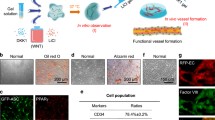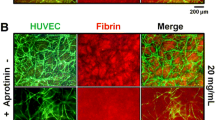Abstract
Co-implantation of adipose-derived stromal cells (ASCs) and endothelial cells (ECs) can markedly expedite the formation of functional microvascular beds and provides possible methods for cell-based revascularization therapies to treat various diseases. Furthermore, we investigated the role of TGFβ/Smad signaling pathway for angiogenesis in a three-dimensional (3D) collagen gel model established in vitro with co-culture between ASCs and ECs. We found that angiogenesis was attenuated in the co-culture gels after inhibition of ALK5/Smad2/3 with SB431542. Genes coding for VEGF-A, VEGF-B, VE-ca, FGF-1, PDGF, BMP-4, and BMP-7 were significantly reduced in both mono-cultured and co-cultured ECs. Furthermore, the decrease in co-cultured ECs was prominent relative to mono-cultured ECs. Taken together, these findings suggest that in the co-culture between ASCs and ECs, TGFβ/Smad signal pathway regulates angiogenesis via ECs; moreover, the findings that the co-cultured ECs were regulated more significantly than mono-cultured ECs suggest that suppression of Smad signal pathway may regulate the paracrine secretion of ASCs to further modulate angiogenesis of ECs.




Similar content being viewed by others
References
Kolonin MG, Evans KW, Mani SA, Gomer RH (2012) Alternative origins of stroma in normal organs and disease. Stem Cell Res 8:312–323
Park IS, Kang JA, Kang J, Rhie JW, Kim SH (2014) Therapeutic effect of human adipose-derived stromal cells cluster in rat hind-limb ischemia. Anat Rec (Hoboken) 297:2289–2298
Abdollahi H, Harris LJ, Zhang P, McIlhenny S, Srinivas V, Tulenko T, DiMuzio PJ (2011) The role of hypoxia in stem cell differentiation and therapeutics. J Surg Res 165:112–117
Cao Y, Sun Z, Liao L, Meng Y, Han Q, Zhao RC (2005) Human adipose tissue-derived stem cells differentiate into endothelial cells in vitro and improve postnatal neovascularization in vivo. Biochem Biophys Res Commun 332:370–379
Shen J, Li S, Chen D (2014) TGF-beta signaling and the development of osteoarthritis. Bone Res 2:14002
Rahman MS, Akhtar N, Jamil HM, Banik RS, Asaduzzaman SM (2015) TGF-β/BMP signaling and other molecular events: regulation of osteoblastogenesis and bone formation. Bone Res 3:15005
Nakao A, Imamura T, Souchelnytskyi S, Kawabata M, Ishisaki A, Oeda E, Tamaki K, Hanai J, Heldin CH, Miyazono K, ten Dijke P (1997) TGF-beta receptor-mediated signalling through Smad2, Smad3 and Smad4. EMBO J 16:5353–5362
Lei C, Zhou XL, Pang Y, Mao YY, Lu XX, Li MJ, Zhang J (2015) TGF-beta signalling prevents pancreatic beta cell death after proliferation. Cell Prolif 48:356–362
Pepper MS (1997) Transforming growth factor-beta: vasculogenesis, angiogenesis, and vessel wall integrity. Cytokine Growth Factor Rev 8:21–43
Attisano L, Carcamo J, Ventura F, Weis FMB, Massague J, Wrana JL (1993) Identification of human activin and tgf-beta type-I receptors that form heteromeric kinase complexes with type-II receptors. Cell 75:671–680
Lux A, Attisano L, Marchuk DA (1999) Assignment of transforming growth factor beta 1 and beta 3 and a third new ligand to the type I receptor ALK-1. J Biol Chem 274:9984–9992
Lebrin F, Goumans MJ, Jonker L, Carvalho RLC, Valdimarsdottir G, Thorikay M, Mummery C, Arthur HM, ten Dijke P (2004) Endoglin promotes endothelial cell proliferation and TGF-beta/ALK1 signal transduction. EMBO J 23:4018–4028
Goumans MJ, Valdimarsdottir G, Itoh S, Lebrin F, Larsson J, Mummery C, Karlsson S, ten Dijke P (2003) Activin receptor-like kinase (ALK)1 is an antagonistic mediator of lateral TGFP/ALK5 signaling. Mol Cell 12:817–828
Itoh F, Itoh S, Carvalho RLC, Adachi T, Ema M, Goumans MJ, Larsson J, Karlsson S, Takahashi S, Mummery CL, ten Dijke P, Kato M (2009) Poor vessel formation in embryos from knock-in mice expressing ALK5 with L45 loop mutation defective in Smad activation. Lab Invest 89:800–810
Goumans MJ, Valdimarsdottir G, Itoh S, Rosendahl A, Sideras P, ten Dijke P (2002) Balancing the activation state of the endothelium via two distinct TGF-beta type I receptors. EMBO J 21:1743–1753
Callahan JF, Burgess JL, Fornwald JA, Gaster LM, Harling JD, Harrington FP, Heer J, Kwon C, Lehr R, Mathur A, Olson BA, Weinstock J, Laping NJ (2002) Identification of novel inhibitors of the transforming growth factor beta1 (TGF-beta1) type 1 receptor (ALK5). J Med Chem 45:999–1001
Inman GJ, Nicolas FJ, Callahan JF, Harling JD, Gaster LM, Reith AD, Laping NJ, Hill CS (2002) SB-431542 is a potent and specific inhibitor of transforming growth factor-beta superfamily type I activin receptor-like kinase (ALK) receptors ALK4, ALK5, and ALK7. Mol Pharmacol 62:65–74
Cun X, Xie J, Lin S, Fu N, Deng S, Xie Q, Zhong J, Lin Y (2015) Gene profile of soluble growth factors involved in angiogenesis, in an adipose-derived stromal cell/endothelial cell co-culture, 3D gel model. Cell Prolif 48:405–412
Gimble JM, Katz AJ, Bunnell BA (2007) Adipose-derived stem cells for regenerative medicine. Circ Res 100:1249–1260
Tobita M, Orbay H, Mizuno H (2011) Adipose-derived stem cells: current findings and future perspectives. Discov Med 11:160–170
Salgado AJ, Reis RL, Sousa NJ, Gimble JM (2010) Adipose tissue derived stem cells secretome: soluble factors and their roles in regenerative medicine. Curr Stem Cell Res Ther 5:103–110
Leung DW, Cachianes G, Kuang WJ, Goeddel DV, Ferrara N (1989) Vascular endothelial growth factor is a secreted angiogenic mitogen. Science 246:1306–1309
Keck PJ, Hauser SD, Krivi G, Sanzo K, Warren T, Feder J, Connolly DT (1989) Vascular permeability factor, an endothelial cell mitogen related to PDGF. Science 246:1309–1312
Takahashi H, Shibuya M (2005) The vascular endothelial growth factor (VEGF)/VEGF receptor system and its role under physiological and pathological conditions. Clin Sci (Lond) 109:227–241
Giannotta M, Trani M, Dejana E (2013) VE-cadherin and endothelial adherens junctions: active guardians of vascular integrity. Dev Cell 26:441–454
Kilvaer TK, Valkov A, Sorbye SW, Smeland E, Bremnes RM, Busund LT, Donnem T (2011) Fibroblast growth factor 2 orchestrates angiogenic networking in non-GIST STS patients. J Transl Med 9:104
Armulik A, Abramsson A, Betsholtz C (2005) Endothelial/pericyte interactions. Circ Res 97:512–523
Saik JE, Gould DJ, Watkins EM, Dickinson ME, West JL (2011) Covalently immobilized platelet-derived growth factor-BB promotes angiogenesis in biomimetic poly(ethylene glycol) hydrogels. Acta Biomater 7:133–143
Potente M, Gerhardt H, Carmeliet P (2011) Basic and therapeutic aspects of angiogenesis. Cell 146:873–887
Laestander C, Engstrom W (2014) Role of fibroblast growth factors in elicitation of cell responses. Cell Prolif 47:3–11
Cao Y, Cao R, Hedlund EM (2008) Regulation of tumor angiogenesis and metastasis by FGF and PDGF signaling pathways. J Mol Med (Berl) 86:785–789
Su N, Jin M, Chen L (2014) Role of FGF/FGFR signaling in skeletal development and homeostasis: learning from mouse models. Bone Res 2:24
Kim JM, Kang SW, Shin SM, Su Kim D, Choi KK, Kim EC, Kim SY (2014) Inhibition of matrix metalloproteinases expression in human dental pulp cells by all-trans retinoic acid. Int J Oral Sci 6:150–153
Tate CM, Pallini R, Ricci-Vitiani L, Dowless M, Shiyanova T, D’Alessandris GQ, Morgante L, Giannetti S, Larocca LM, di Martino S, Rowlinson SW, De Maria R, Stancato L (2012) A BMP7 variant inhibits the tumorigenic potential of glioblastoma stem-like cells. Cell Death Differ 19:1644–1654
Shin JA, Lim SM, Jeong SI, Kang JL, Park EM (2014) Noggin improves ischemic brain tissue repair and promotes alternative activation of microglia in mice. Brain Behav Immun 40:143–154
Chim SM, Tickner J, Chow ST, Kuek V, Guo B, Zhang G, Rosen V, Erber W, Xu J (2013) Angiogenic factors in bone local environment. Cytokine Growth Factor Rev 24:297–310
Acknowledgments
This work was funded by the National Natural Science Foundation of China (81470721, 31170929), Sichuan Province Youth Science and Technology Innovation Team (2014TD0001).
Author information
Authors and Affiliations
Corresponding author
Additional information
Shiyu Lin and Jing Xie contributed equally to this work.
Rights and permissions
About this article
Cite this article
Lin, S., Xie, J., Gong, T. et al. Smad signal pathway regulates angiogenesis via endothelial cell in an adipose-derived stromal cell/endothelial cell co-culture, 3D gel model. Mol Cell Biochem 412, 281–288 (2016). https://doi.org/10.1007/s11010-015-2634-5
Received:
Accepted:
Published:
Issue Date:
DOI: https://doi.org/10.1007/s11010-015-2634-5




